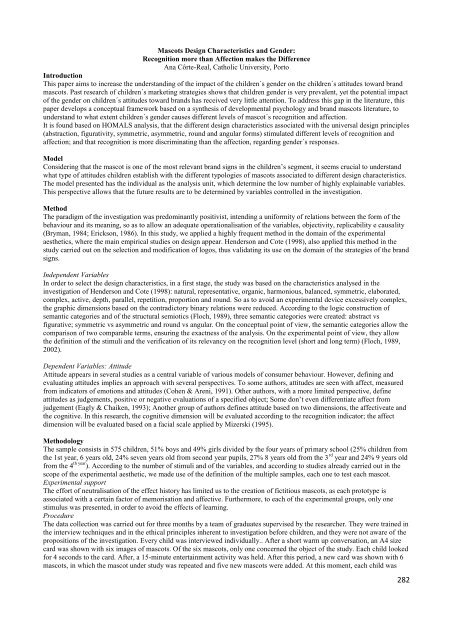Brand, Identity and Reputation: Exploring, Creating New Realities ...
Brand, Identity and Reputation: Exploring, Creating New Realities ...
Brand, Identity and Reputation: Exploring, Creating New Realities ...
Create successful ePaper yourself
Turn your PDF publications into a flip-book with our unique Google optimized e-Paper software.
Mascots Design Characteristics <strong>and</strong> Gender:<br />
Recognition more than Affection makes the Difference<br />
Ana Côrte-Real, Catholic University, Porto<br />
Introduction<br />
This paper aims to increase the underst<strong>and</strong>ing of the impact of the children´s gender on the children´s attitudes toward br<strong>and</strong><br />
mascots. Past research of children´s marketing strategies shows that children gender is very prevalent, yet the potential impact<br />
of the gender on children´s attitudes toward br<strong>and</strong>s has received very little attention. To address this gap in the literature, this<br />
paper develops a conceptual framework based on a synthesis of developmental psychology <strong>and</strong> br<strong>and</strong> mascots literature, to<br />
underst<strong>and</strong> to what extent children´s gender causes different levels of mascot´s recognition <strong>and</strong> affection.<br />
It is found based on HOMALS analysis, that the different design characteristics associated with the universal design principles<br />
(abstraction, figurativity, symmetric, asymmetric, round <strong>and</strong> angular forms) stimulated different levels of recognition <strong>and</strong><br />
affection; <strong>and</strong> that recognition is more discriminating than the affection, regarding gender´s responses.<br />
Model<br />
Considering that the mascot is one of the most relevant br<strong>and</strong> signs in the children‘s segment, it seems crucial to underst<strong>and</strong><br />
what type of attitudes children establish with the different typologies of mascots associated to different design characteristics.<br />
The model presented has the individual as the analysis unit, which determine the low number of highly explainable variables.<br />
This perspective allows that the future results are to be determined by variables controlled in the investigation.<br />
Method<br />
The paradigm of the investigation was predominantly positivist, intending a uniformity of relations between the form of the<br />
behaviour <strong>and</strong> its meaning, so as to allow an adequate operationalisation of the variables, objectivity, replicability e causality<br />
(Bryman, 1984; Erickson, 1986). In this study, we applied a highly frequent method in the domain of the experimental<br />
aesthetics, where the main empirical studies on design appear. Henderson <strong>and</strong> Cote (1998), also applied this method in the<br />
study carried out on the selection <strong>and</strong> modification of logos, thus validating its use on the domain of the strategies of the br<strong>and</strong><br />
signs.<br />
Independent Variables<br />
In order to select the design characteristics, in a first stage, the study was based on the characteristics analysed in the<br />
investigation of Henderson <strong>and</strong> Cote (1998): natural, representative, organic, harmonious, balanced, symmetric, elaborated,<br />
complex, active, depth, parallel, repetition, proportion <strong>and</strong> round. So as to avoid an experimental device excessively complex,<br />
the graphic dimensions based on the contradictory binary relations were reduced. According to the logic construction of<br />
semantic categories <strong>and</strong> of the structural semiotics (Floch, 1989), three semantic categories were created: abstract vs<br />
figurative; symmetric vs asymmetric <strong>and</strong> round vs angular. On the conceptual point of view, the semantic categories allow the<br />
comparison of two comparable terms, ensuring the exactness of the analysis. On the experimental point of view, they allow<br />
the definition of the stimuli <strong>and</strong> the verification of its relevancy on the recognition level (short <strong>and</strong> long term) (Floch, 1989,<br />
2002).<br />
Dependent Variables: Attitude<br />
Attitude appears in several studies as a central variable of various models of consumer behaviour. However, defining <strong>and</strong><br />
evaluating attitudes implies an approach with several perspectives. To some authors, attitudes are seen with affect, measured<br />
from indicators of emotions <strong>and</strong> attitudes (Cohen & Areni, 1991). Other authors, with a more limited perspective, define<br />
attitudes as judgements, positive or negative evaluations of a specified object; Some don‘t even differentiate affect from<br />
judgement (Eagly & Chaiken, 1993); Another group of authors defines attitude based on two dimensions, the affectiveate <strong>and</strong><br />
the cognitive. In this research, the cognitive dimension will be evaluated according to the recognition indicator; the affect<br />
dimension will be evaluated based on a facial scale applied by Mizerski (1995).<br />
Methodology<br />
The sample consists in 575 children, 51% boys <strong>and</strong> 49% girls divided by the four years of primary school (25% children from<br />
the 1st year, 6 years old, 24% seven years old from second year pupils, 27% 8 years old from the 3 rd year <strong>and</strong> 24% 9 years old<br />
from the 4 th year ). According to the number of stimuli <strong>and</strong> of the variables, <strong>and</strong> according to studies already carried out in the<br />
scope of the experimental aesthetic, we made use of the definition of the multiple samples, each one to test each mascot.<br />
Experimental support<br />
The effort of neutralisation of the effect history has limited us to the creation of fictitious mascots, as each prototype is<br />
associated with a certain factor of memorisation <strong>and</strong> affective. Furthermore, to each of the experimental groups, only one<br />
stimulus was presented, in order to avoid the effects of learning.<br />
Procedure<br />
The data collection was carried out for three months by a team of graduates supervised by the researcher. They were trained in<br />
the interview techniques <strong>and</strong> in the ethical principles inherent to investigation before children, <strong>and</strong> they were not aware of the<br />
propositions of the investigation. Every child was interviewed individually.. After a short warm up conversation, an A4 size<br />
card was shown with six images of mascots. Of the six mascots, only one concerned the object of the study. Each child looked<br />
for 4 seconds to the card. After, a 15-minute entertainment activity was held. After this period, a new card was shown with 6<br />
mascots, in which the mascot under study was repeated <strong>and</strong> five new mascots were added. At this moment, each child was<br />
282
















